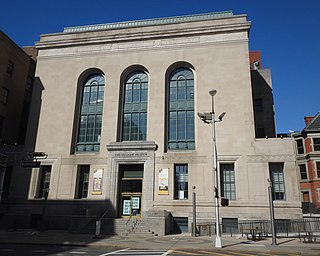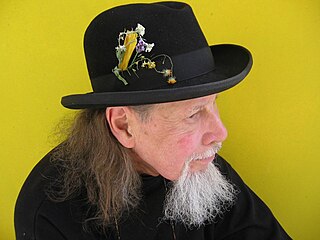Related Research Articles

Dalai Lama is a title given by Altan Khan in 1578 AD at Yanghua Monastery to the foremost spiritual leader of the Gelug or "Yellow Hat" school of Tibetan Buddhism, the newest and most dominant of the four major schools of Tibetan Buddhism. The 14th and incumbent Dalai Lama is Tenzin Gyatso, who lives in exile as a refugee in India. The Dalai Lama is considered to be the successor in a line of tulkus who are believed to be incarnations of Avalokiteśvara, the Bodhisattva of Compassion.

Joseph Heinrich Beuys was a German artist, teacher, performance artist, and art theorist whose work reflected concepts of humanism, sociology, and, with Heinrich Böll, Johannes Stüttgen, Caroline Tisdall, Robert McDowell, and Enrico Wolleb, created the Free International University for Creativity & Interdisciplinary Research (FIU). He previously in his talks and performances also formed The Party for Animals and The Organisation for Direct Democracy. He was a member of a Dadaist art movement Fluxus and singularly inspirational in developing of Performance Art, called Kunst Aktionen, alongside Wiener Aktionismus that Allan Kaprow and Carolee Schneemann termed Art Happenings. Today, internationally, the largest performance art group is BBeyond in Belfast, led by Alastair MacLennan who knew Beuys and like many adapts Beuys's ethos.

The Gelug is the newest of the four major schools of Tibetan Buddhism. It was founded by Je Tsongkhapa (1357–1419), a Tibetan philosopher, tantric yogi and lama and further expanded and developed by his disciples.

Robert Alexander Farrar Thurman is an American Buddhist author and academic who has written, edited, and translated several books on Tibetan Buddhism. He was the Je Tsongkhapa Professor of Indo-Tibetan Buddhist Studies at Columbia University, before retiring in June 2019. He was the first endowed chair in Buddhist Studies in the West. He also is the co-founder and president of the Tibet House US New York. He translated the Vimalakirti Sutra from the Tibetan Kanjur into English. He is the father of actress Uma Thurman.
A tulku is a distinctive and significant aspect of Tibetan Buddhism, embodying the concept of enlightened beings taking corporeal forms to continue the lineage of specific teachings. The term "tulku" has its origins in the Tibetan word "sprul sku", which originally referred to an emperor or ruler taking human form on Earth, signifying a divine incarnation. Over time, this term evolved within Tibetan Buddhism to denote the corporeal existence of highly accomplished Buddhist masters whose purpose is to ensure the preservation and transmission of a particular lineage.

The Newark Museum of Art, formerly known as the Newark Museum, in Newark, Essex County, New Jersey is the state's largest museum. It holds major collections of American art, decorative arts, contemporary art, and arts of Asia, Africa, the Americas, and the ancient world. Its extensive collections of American art include works by Hiram Powers, Thomas Cole, John Singer Sargent, Albert Bierstadt, Frederick Church, Childe Hassam, Mary Cassatt, Edward Hopper, Georgia O'Keeffe, Joseph Stella, Tony Smith and Frank Stella.

An international, loosely affiliated group of nonprofit, cultural preservation organizations founded at the request of the Dalai Lama, the Tibet House's preserve, present, and protect Tibet's ancient traditions of philosophy, mind science, art, and culture due to the Chinese invasion of Tibet in 1950 and subsequent Tibetan diaspora. The first Tibet House was founded in New Delhi, India in 1965.
Tibetan Americans are Americans of Tibetan ancestry. As of 2020, more than 26,700 Americans are estimated to have Tibetan ancestry. The majority of Tibetan Americans reside in Queens, New York.
Ngawang Wangyal, aka Sogpo (Mongolian) Wangyal, popularly known as Geshe Wangyal and "America's first lama," was a Buddhist lama and scholar of Kalmyk origin. He was born in the Astrakhan province in southeast Russia sometime in 1901 and died in West Palm Beach, Florida in 1983. He came to the United States from Tibet in 1955 and was the spiritual leader of the Kalmuk Buddhist community in Freewood Acres, New Jersey at the Rashi Gempil-Ling Buddhist Temple. He is considered a "founding figure" of Buddhism in the West.

Willoughby Sharp was an American artist, independent curator, independent publisher, gallerist, teacher, author, and telecom activist. Avalanche published interviews they conducted with contemporary artists such as Vito Acconci, Dennis Oppenheim and Yvonne Rainer. Sharp also was contributing editor to four other publications: Impulse (1979–1981); Video magazine (1980–1982); Art Com (1984–1985), and the East Village Eye (1984–1986). He published three monographs on contemporary artists, contributed to many exhibition catalogues, and wrote on art for Artforum, Art in America, Arts magazine, Laica Journal, Quadrum and Rhobo. He was editor of the Public Arts International/Free Speech documentary booklet in 1979. Sharp received numerous grants, awards, and fellowships; both as an individual or under the sponsorship of non-profit arts organizations.

Glenn H. Mullin is a Tibetologist, Buddhist writer, translator of classical Tibetan literature and teacher of Tantric Buddhist meditation.

Bruce Alan Wallace is an American author and expert on Tibetan Buddhism. His books discuss Eastern and Western scientific, philosophical, and contemplative modes of inquiry, often focusing on the relationships between science and Buddhism. He is founder of the Santa Barbara Institute for Consciousness Studies.

Kumbum Monastery, also called Ta'er Temple, is a Tibetan gompa in Lusar, Huangzhong County, Xining, Qinghai, China. It was founded in 1583 in a narrow valley close to the village of Lusar in the historical Tibetan region of Amdo. Its superior monastery is Drepung Monastery, immediately to the west of Lhasa. It is ranked in importance as second only to Lhasa.

The 14th Dalai Lama is, as the incumbent Dalai Lama, the highest spiritual leader and head of Tibetan Buddhism. By the adherents of Tibetan Buddhism, he is considered a living Bodhisattva; specifically, an emanation of Avalokiteśvara in Sanskrit, and Chenrezig in Tibetan. He is also the leader and a monk of the Gelug school, the newest school of Tibetan Buddhism, formally headed by the Ganden Tripa. The central government of Tibet at the time of his selection, the Ganden Phodrang, invested the Dalai Lama with temporal duties until his exile in 1959.

The Free International University (FIU) for Creativity and Interdisciplinary Research was a support organization founded by the German artist Joseph Beuys. He founded it together with writer Heinrich Böll, Klaus Staeck, Georg Meistermann and Willi Bongard (secretary), Caroline Tisdall and Robert McDowell who wrote the FIU's feasibility report for the EC's Ralph Dahrendorf, and Enrico Wolleb, R.D. Laing, Tapio Varis, Dorothy Walker, Conrad Atkinson, Dr. Rhea Thöngens, and many others, based on principles laid down in a manifesto written by Joseph Beuys and Heinrich Böll and the 1975/6 feasibility study by art critic Caroline Tisdall. It was founded as a "organizational place of research, work, and communication" to ponder the future of society including political-economy. As a free University it was intended to supplement the state educational system with interdisciplinary work and cooperation between the sciences and the arts while at the same time campaigning for legal equality within educational systems.

Losang Samten is a Tibetan-American scholar, sand mandala artist, former Buddhist monk, and Spiritual Director of the Chenrezig Tibetan Buddhist Center of Philadelphia. He is one of only an estimated 30 people worldwide who are qualified to teach the traditional art of Tibetan sandpainting. He has written two books and helped to create the first Tibetan sand mandala ever shown publicly in the West in 1988. In 2002, he was made a National Heritage Fellow by the National Endowment of the Arts. In 2004, he was granted a Pew Fellowship in Folk and Traditional Arts.

The Tibet Center, also known as Kunkhyab Thardo Ling, is a dharma center for the study of Tibetan Buddhism. Founded by Venerable Khyongla Rato Rinpoche in 1975, it is one of the oldest Tibetan Buddhist centers in New York City. The current director is Khen Rinpoche Nicholas Vreeland, the abbot of Rato Dratsang monastery. Philip Glass assisted with the founding of The Tibet Center. Since 1991 TTC has invited and hosted the 14th Dalai Lama for teaching events in New York in partnership with the Gere Foundation.

Nicholas Vreeland, also known as Rato Khen Rinpoche, Geshe Thupten Lhundup, is a fully ordained Tibetan Buddhist monk who is the abbot of Rato Dratsang Monastery, a 10th-century Tibetan Buddhist monastery reestablished in India. Vreeland is also a photographer. He is the son of Ambassador Frederick Vreeland and grandson of Diana Vreeland, the fashion editor.
Louwrien Wijers is a Dutch artist and writer working in Ferwert. She was involved with the Fluxus art movement and worked with Joseph Beuys from 1968 through 1986. Like Beuys, she considers writing and speaking as sculpture. She makes what she calls "mental sculpture" as well as material sculpture. From 1965 on she has written on art for the Museum Journaal, Algemeen Handelsblad, Hitweek, het Financieele Dagblad and in several international books, magazines and publications. In 1970 she began making art.

Tibet House US (THUS) is a Tibetan cultural preservation and education 501(c)(3) nonprofit founded in 1987 in New York City by a group of Westerners after the Fourteenth Dalai Lama, Tenzin Gyatso, expressed his wish to establish a cultural institution to build awareness of Tibetan culture.
References
- ↑ "Art Corporation of America Incorporated BRIDGING 1977". summerhall.co.uk. Summerhall Festival 2017. Retrieved 19 November 2019.
- 1 2 Carey, Brainard (September 29, 2017). "John Halpern". WYBC, Yale University Radio. Praxis Interview Magazine, Museum of Nonvisible Art. Retrieved 18 November 2019.
- ↑ "Performance: Tantric Voyages: A Living Cinema Event". theartguide.comt. The Art Guide. Retrieved 20 November 2019.
- ↑ Tarozzi Goldsmith, Marcella (September 1, 1999). Future of Art, The: An Aesthetics of the New and the Sublime. SUNY Press. p. 80. ISBN 978-0-7914-4315-6 . Retrieved 18 November 2019.
- ↑ Haw, Richard (February 25, 2008). Art of the Brooklyn Bridge: A Visual History. Routledge. pp. 263–264. ISBN 978-0415953863 . Retrieved 19 November 2019.
- ↑ "Manhattan Artist Seized In Case of Bridge 'Bomb'". New York Times. August 5, 1979. Retrieved 19 November 2019.
- ↑ "Wide Brush Needed to Cover Artists' Interests". New York Times. January 1, 1980. Retrieved 20 November 2019.
- ↑ "kunstenaars (artists), Halpern, John". nationaalarchief.nl/. National Archives of the Netherlands (Nationaal Archief). Retrieved 20 November 2019.
- ↑ "MAKING A DIFFERENCE" FRESH AIR ON WNBC / TV "ART-PLAY". ""Making a Difference" Fresh Air on WNBC/TV "Art Play"". youtube.com. Halpern. Retrieved 20 November 2019.
- ↑ Sutton, Benjamin (November 21, 2017). "Finally, a Joseph Beuys Documentary". Hyperallergic. Retrieved 18 November 2019.
- ↑ "Director of the Guggenheim on Joseph Beuys (1979)". youtube.com. Beuys TV. Retrieved 19 November 2019.
- ↑ "Art, Architecture, and Innovation: Celebrating the Guggenheim Museum". youtube.com. Guggenheim Museum. Retrieved 18 November 2019.
- ↑ "Ronald Feldman on Joseph Beuys". youtube.com. BeuysTV. Retrieved 19 November 2019.
- ↑ Joseph Beuys, transformer. World Catalog. OCLC 70792713.
- ↑ Fisher, Kenny (May 12, 2006). "Westerns Drawn to Eastern Thought in 'Refuge'". New York Times. Retrieved 19 November 2019.
- ↑ "'Here We Enjoy Freedom,' Says Dalai Lama". Office of His Holiness the Dalai Lama. November 1, 2007. Retrieved 19 November 2019.
- ↑ Piazza, Judyth (January 6, 2012). "Documentary Filmmaker John Halpern Talks Film on The American Perspective". SOP. The American Perspective. Retrieved 19 November 2019.
- ↑ Peterson, Kristen (July 2, 2009). "Revisiting the building blocks of their career". Las Vegas Sun. Retrieved 19 November 2019.
- ↑ La Gorce, Tammy; Sulzburger, A.G. (March 13, 2009). "To Save a Venturi House, It Is Moved". New York Times. Retrieved 19 November 2019.
- ↑ Enriquez, Susana (March 12, 2009). "N.J. house readied for voyage to Glen Cove". Newsday. Retrieved 19 November 2019.
- ↑ Offenhartz, Jake (26 September 2019). "Battle Over Park Slope Bike Lane Gets Physical: 'You Wanna Clown Around With Me?'". Gothamist. New York. Retrieved 7 September 2020.
- ↑ Gordon, Doug (September 26, 2019). "Bikelash's Latest Tactics: Pedophile Smears and Conspiracy Theories". Streetsblog, Streetfilm. Retrieved 28 October 2020.
- ↑ Halpern, John; Sliwa, Maria (September 8, 2012). "Tibet's Self Murder: Tragedy or Transformation?". Huffington Post. Retrieved 19 November 2019.